Let’s be honest – finding the right books for your 7-year-old can feel like mission impossible. You’re standing in the library with a kid who’s outgrown picture books but isn’t quite ready for Harry Potter, and everything in between seems either too babyish or way too advanced. Sound familiar?
According to Bedtime Stories Free, children’s story preferences at age 7 show a fascinating shift toward more complex narratives featuring magical elements, friendship dynamics, and problem-solving adventures. I remember when my nephew turned 7 – suddenly, those simple picture books weren’t cutting it anymore. He craved stories with real substance, characters who faced challenges, and plots that kept him guessing until the very end.
Here’s what I’ve learned from watching kids this age: they want to be taken seriously as readers, but they still need stories that won’t frustrate them. They’re ready for chapter books but still love illustrations. They want heroes they can relate to and adventures that feel both exciting and achievable.
I’ve put together a list of 25 stories for 7 year olds that actually work – books that hit that sweet spot between challenging and accessible, entertaining and meaningful. These aren’t just random picks; they’re battle-tested favorites that have turned countless reluctant readers into book lovers.
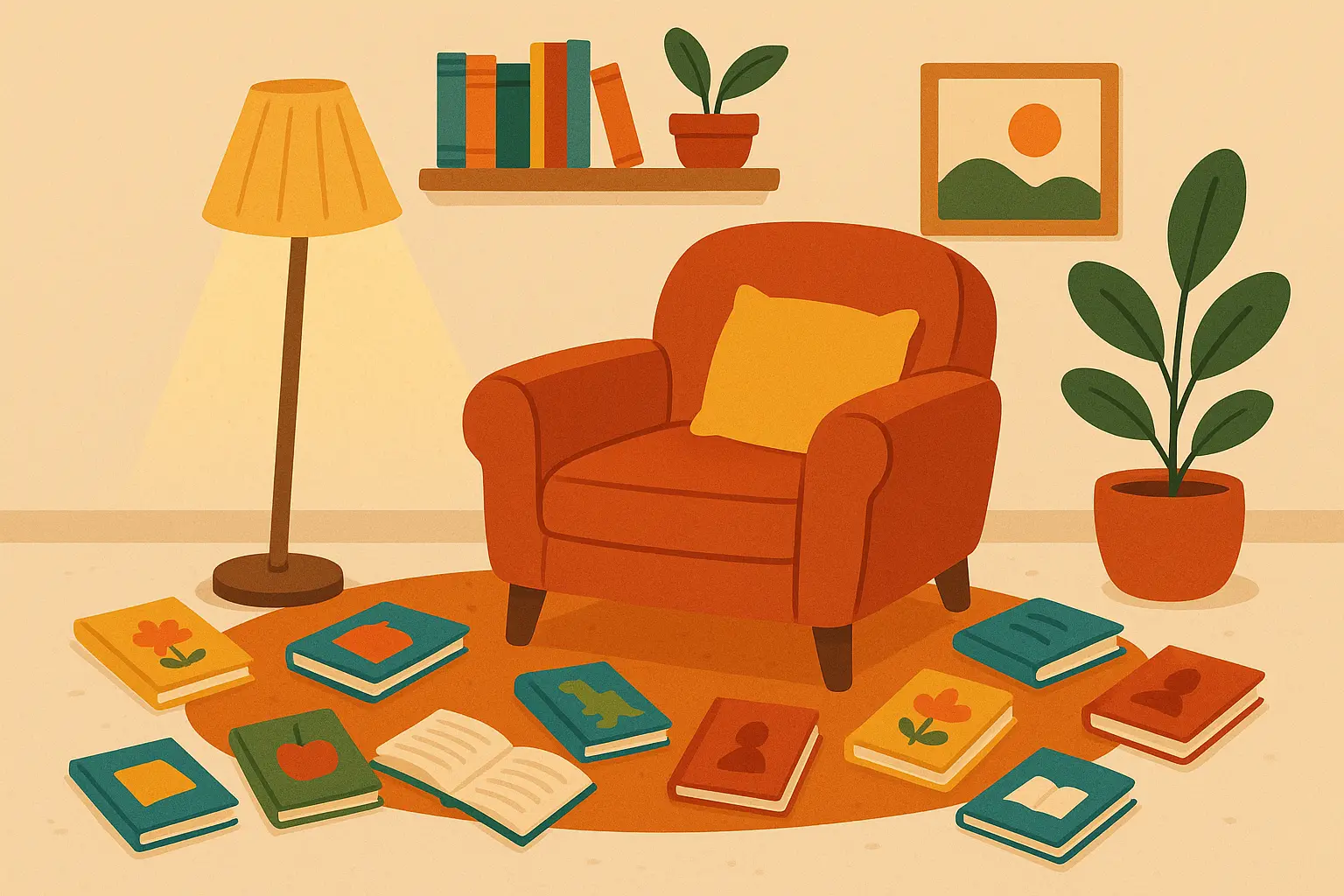
Table of Contents
-
What Makes a Great Story for 7 Year Olds
-
Adventure and Fantasy Stories (5 Stories)
-
Friendship and Social Stories (5 Stories)
-
Mystery and Problem-Solving Stories (4 Stories)
-
Educational and STEM Stories (4 Stories)
-
Diverse and Cultural Stories (4 Stories)
-
Humor and Light-hearted Stories (3 Stories)
-
Why These Stories Actually Work
-
Making Reading Time Work in Real Life
-
How Nairrate Can Help Create Perfect Stories
-
Final Thoughts
TL;DR
-
Seven-year-olds need chapter books with 500-1,500 words that feel grown-up but aren’t overwhelming
-
They can focus for 15-30 minutes, so stories need good stopping points
-
Friends, feelings, and figuring things out are huge themes at this age
-
Pictures still help, especially in early chapter books
-
Adventure stories feed their growing imaginations
-
Mystery books make them feel super smart when they solve clues
-
Diverse stories show them the world is bigger than their neighborhood
-
Funny books help them deal with stress and connect with friends
-
Educational stories work best when kids don’t realize they’re learning
-
Series books create reading addicts (in the best way)
What Makes a Great Story for 7 Year Olds
Here’s what I’ve learned from watching kids this age devour books: they’re not just looking for entertainment, they’re looking for stories that make them feel capable and understood. They want to tackle bigger ideas but still need the right support to get there.
When selecting age-appropriate content, understanding what makes effective bedtime stories for kids can provide valuable insights into narrative structures that engage young readers while promoting positive developmental outcomes.
Reading Levels That Won’t Frustrate Your Kid
Seven-year-olds are in this weird in-between stage. They’ve outgrown “See Spot Run” but they’re not ready for novels with tiny print and no pictures. The sweet spot is books with 500-1,500 words that use everyday language while sneaking in some challenging vocabulary.
Here’s what works: stories where new words are surrounded by enough context that kids can figure them out on their own. This builds confidence while expanding their vocabulary naturally. Think of it like training wheels – there’s support, but they’re still doing the real work.
|
Reading Level |
What It Looks Like |
Word Count |
What Kids Can Handle |
|---|---|---|---|
|
Early 1st Grade |
Big print, lots of pictures |
500-800 words |
Simple sentences, familiar words |
|
Late 1st Grade |
Smaller print, some pictures |
800-1,200 words |
Longer sentences, some tricky words |
|
Early 2nd Grade |
Chapter books with illustrations |
1,000-1,500 words |
Complex sentences, context clues |
|
Advanced 2nd Grade |
Fewer pictures, more text |
1,200-2,000 words |
Rich vocabulary, deeper themes |
Attention Spans and Story Structure That Actually Work
Good news: 7-year-olds can focus for 15-30 minutes on a story they actually like. The key is giving them natural break points so they don’t feel overwhelmed.
Chapter books work great because each chapter is like a mini-story with its own beginning, middle, and end. Kids feel accomplished finishing a chapter, and the cliffhangers keep them coming back for more.
Take the Magic Tree House series – each chapter is about 6-7 pages, perfect for one sitting. Jack and Annie always end chapters at exciting moments, so kids naturally want to keep reading. It’s like the literary equivalent of “just one more episode.”
Emotions and Social Stuff They’re Dealing With
At 7, kids are figuring out friendship drama, fairness, and how to handle big feelings. The best stories give them a safe space to explore these themes through characters they care about.
They’re also developing empathy – they can understand how other people feel and why they make certain choices. Stories that show characters working through problems help kids practice these skills in a low-stakes environment.
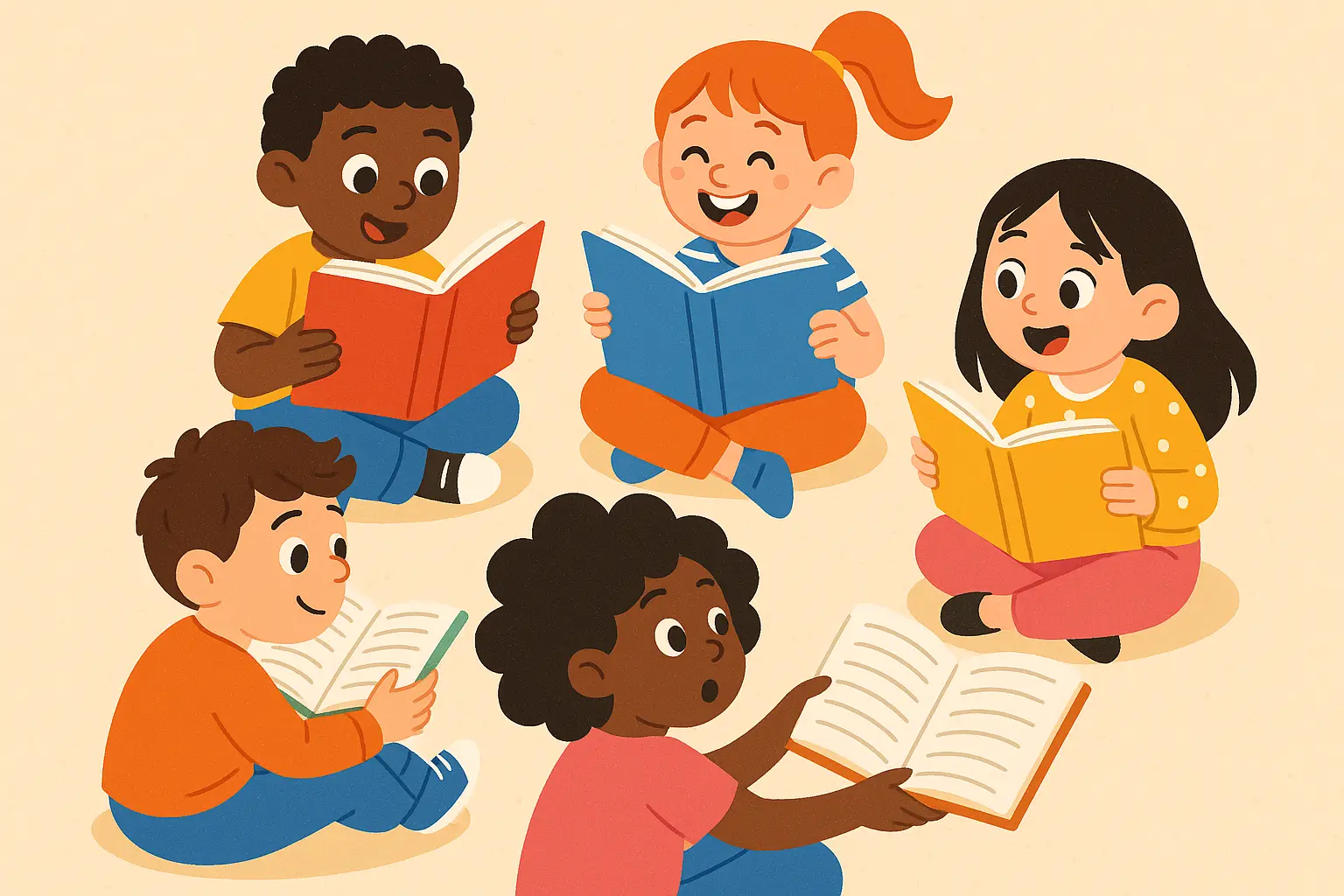
Learning That Doesn’t Feel Like School
The best educational stories are sneaky about it. Kids think they’re just reading about dinosaurs or magic, but they’re actually picking up vocabulary, historical facts, and scientific concepts.
The trick is weaving learning into the adventure. When Jack and Annie travel back to ancient Egypt, kids absorb information about pyramids and pharaohs because it’s part of the exciting story, not a separate lesson.
Adventure and Fantasy Stories (5 Stories)
These are the books that turn kids into reading addicts. Adventure and fantasy stories feed their growing imaginations while introducing them to bigger, more complex ideas about bravery, friendship, and problem-solving.
For readers seeking more adventure options beyond these selections, exploring must-read adventure stories can provide additional inspiration for young readers ready to embark on thrilling literary journeys.
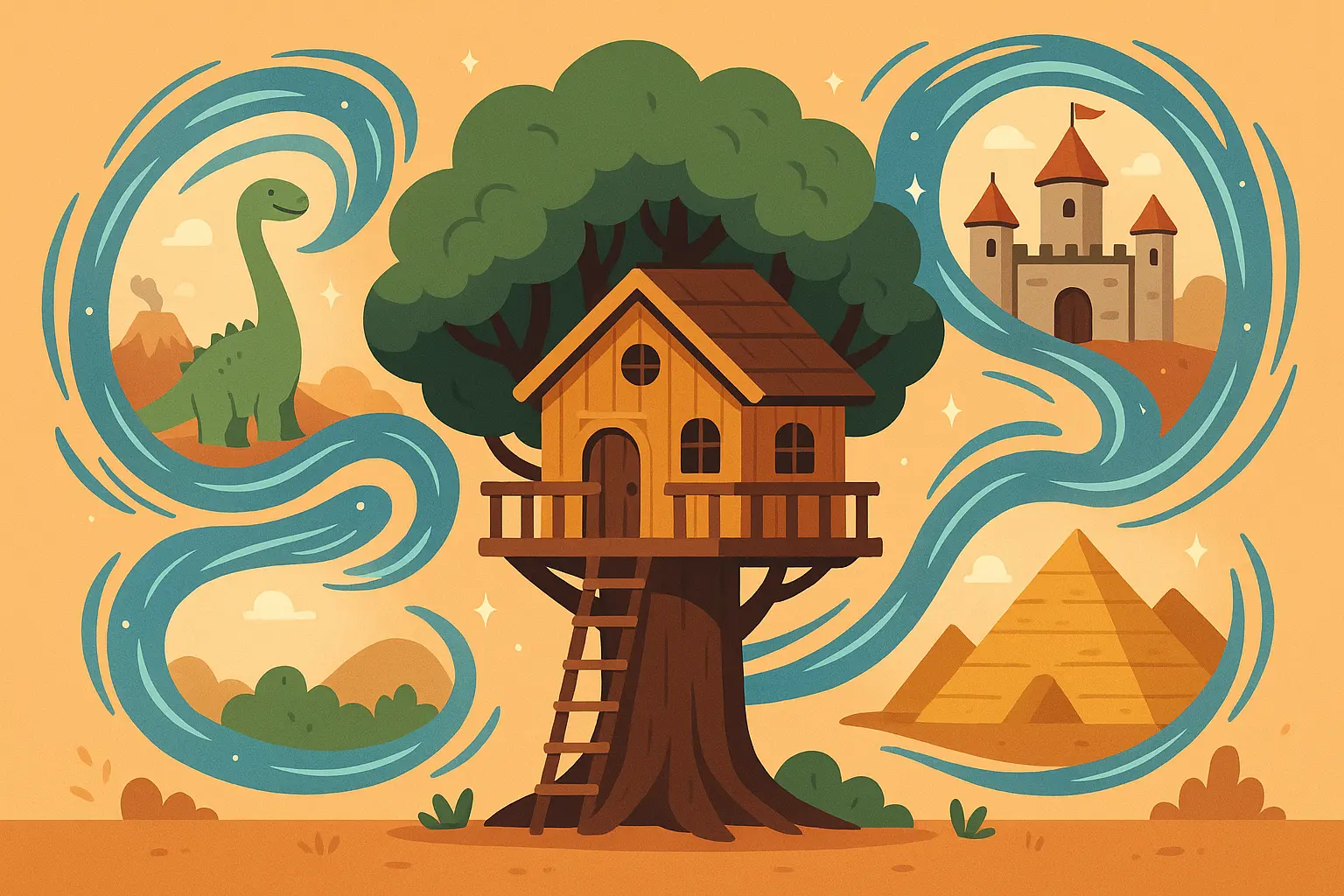
1. The Magic Tree House Series – “Dinosaurs Before Dark”
This is like crack for beginning readers (in the best way). Mary Pope Osborne figured out the perfect formula: take two relatable kids, add a magical tree house that travels through time, and send them on adventures that are exciting but not scary.
Jack and Annie’s first trip takes them to see dinosaurs, which is basically every 7-year-old’s dream come true. The 68-page format is just right – long enough to feel like a “real” book, short enough to finish in one sitting. And the historical facts? Kids absorb them without even realizing they’re learning.
Trust me, once your kid discovers these books, you’ll be making weekly library trips. There are over 30 books in the series, so you’re set for a while.
2. The Princess in Black Series
Shannon Hale took the princess stereotype and turned it upside down. Princess Magnolia looks like a typical fairy-tale princess, but she’s secretly a superhero who fights monsters. It’s like having a secret identity, which every 7-year-old can relate to.
The books are about 90 pages with illustrations on every page, making them perfect for kids who still need visual support. Plus, the message is amazing: you don’t have to choose between being girly and being strong. You can be both.
3. Mercy Watson Series
Kate DiCamillo created something magical with Mercy Watson – a pig who thinks she’s a person. These stories for kids are hilarious and heartwarming, showing what unconditional love looks like through the eyes of devoted pet owners.
The humor works on multiple levels, so adults actually enjoy reading these too. And Mercy’s adventures teach kids about family, consequences, and finding joy in simple things – like buttered toast.
4. The Bad Kitty Series
Nick Bruel’s Bad Kitty is every pet owner’s nightmare and every kid’s dream pet rolled into one. The combination of text and comic-style illustrations keeps kids engaged while teaching them about cause and effect.
Bad Kitty learns from her mistakes through natural consequences, not lectures. Kids see that actions have results, but they’re too busy laughing at the cat’s antics to feel preached to.
5. Wings of Fire: The Brightest Night (Graphic Novel)
This graphic novel version of Tui T. Sutherland’s dragon fantasy makes complex themes accessible through visual storytelling. Dragons, prophecies, and friendship drama – what more could a 7-year-old want?
The graphic format helps kids understand complicated plot points and character relationships that might be overwhelming in text-only format. It’s like training wheels for more complex fantasy stories.
Friendship and Social Stories (5 Stories)
These books are like having a practice run for real-life social situations. Seven-year-olds are navigating friendship drama, figuring out where they fit in, and learning how to handle conflicts. These stories give them roadmaps for handling tricky social situations.
6. Ivy and Bean Series
Annie Barrows created the perfect unlikely friendship. Ivy is the quiet, bookish kid who loves magic, while Bean is the loud, impulsive one always ready for adventure. They shouldn’t be friends, but they are, and that’s what makes it beautiful.
The dialogue sounds exactly like how kids actually talk, which makes the characters instantly relatable. When Ivy and Bean have disagreements, they work through them like real friends do – with compromise, understanding, and sometimes a little stubbornness.
In one book, they decide to become paleontologists and start digging for fossils in Bean’s backyard. Ivy wants to research everything first, while Bean just wants to start digging. Sound familiar? It’s like every group project ever, but they figure out how to work together.
7. Junie B. Jones Series
Barbara Park captured exactly how kindergarteners think and talk, including the grammatical mistakes and stream-of-consciousness storytelling. Junie B. says what she thinks, gets into trouble, and learns from her mistakes in very kid-like ways.
Some parents worry about the grammar issues, but kids understand that Junie B. is still learning, just like they are. The books help them feel understood while gently showing better ways to handle situations.
8. Dork Diaries: Tales from a Not-So-Fabulous Life
Rachel Renée Russell’s diary-style series tackles middle school social drama through a format that feels like reading someone’s private diary. The combination of text and doodles makes it accessible for younger readers who aren’t quite ready for pure text.
While it’s technically for older kids, advanced 7-year-olds love getting a peek at what’s coming next in their social development. It’s like a preview of future friend drama, but from a safe distance.
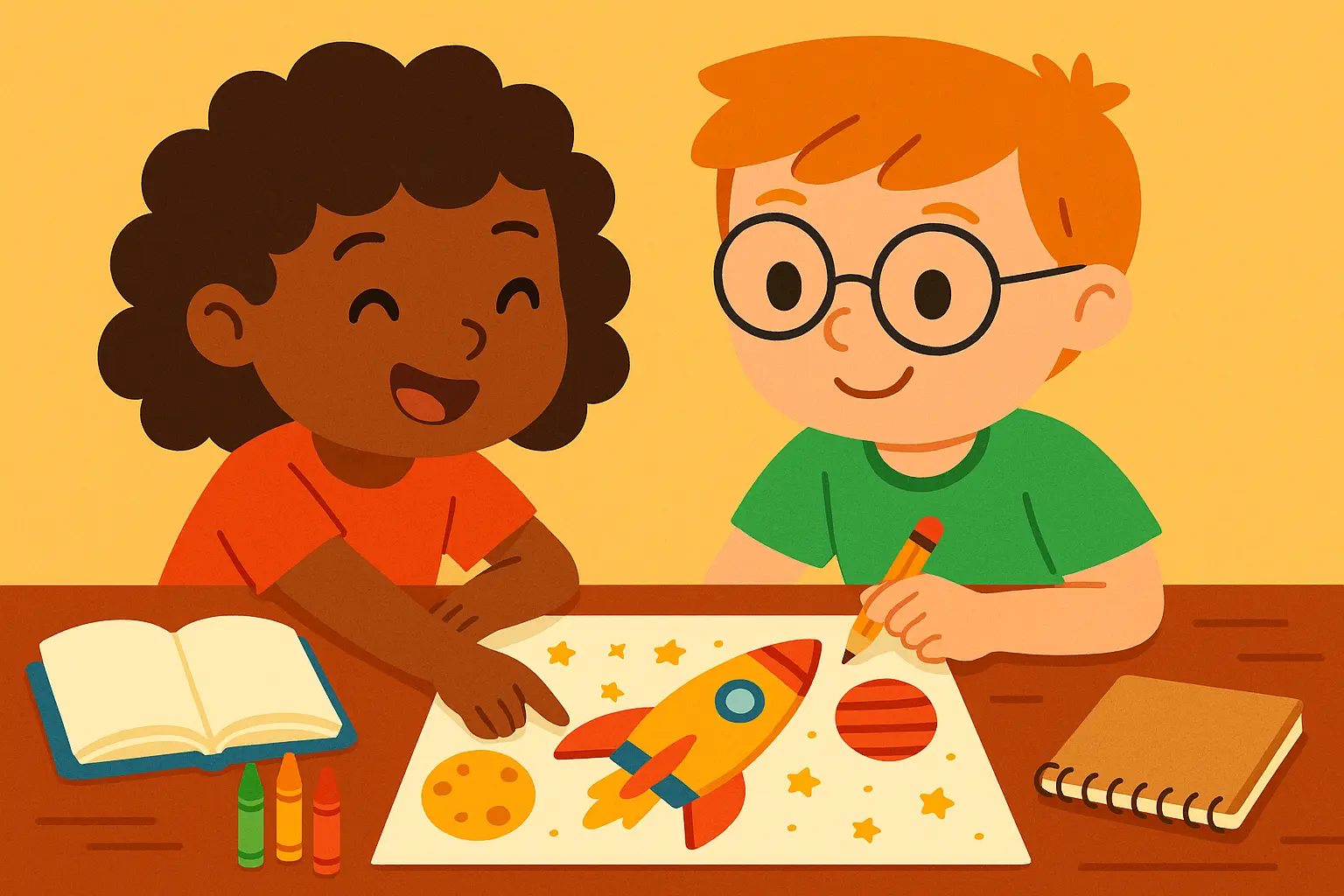
9. The Babysitters Club Graphic Novels
Raina Telgemeier’s adaptations of Ann M. Martin’s classic series make complex social dynamics accessible through professional comic formatting. The visual storytelling helps kids understand subtle social cues and emotional expressions that they might miss in text-only stories.
These books tackle responsibility, leadership, and friendship conflicts while maintaining the core message that friends can work through problems together. The graphic format makes it easier for kids to follow multiple characters and storylines.
10. New Kid
Jerry Craft’s graphic novel follows Jordan as he navigates being one of the few kids of color at his new school. It addresses identity, belonging, and friendship through relatable situations that help kids understand different perspectives.
The story gives kids vocabulary and frameworks for discussing diversity and belonging – crucial concepts for 7-year-olds who are starting to notice social differences but might not know how to talk about them.
Mystery and Problem-Solving Stories (4 Stories)
These books make kids feel like detectives and geniuses. Mystery stories develop critical thinking skills while entertaining young readers who love puzzles and figuring things out.
Young readers who enjoy solving puzzles and mysteries might also appreciate exploring must-read mystery stories that challenge their deductive reasoning skills while providing age-appropriate thrills and suspense.
11. Cam Jansen Series
David A. Adler created a detective with a photographic memory, which is every kid’s superpower fantasy. When Cam says “Click,” she takes a mental picture that she can examine later for clues.
Each book is about 60 pages of neighborhood mysteries – lost pets, missing items, small crimes that feel important to kids. The repetitive structure builds confidence while developing observation skills. Kids start looking for clues in their own lives.
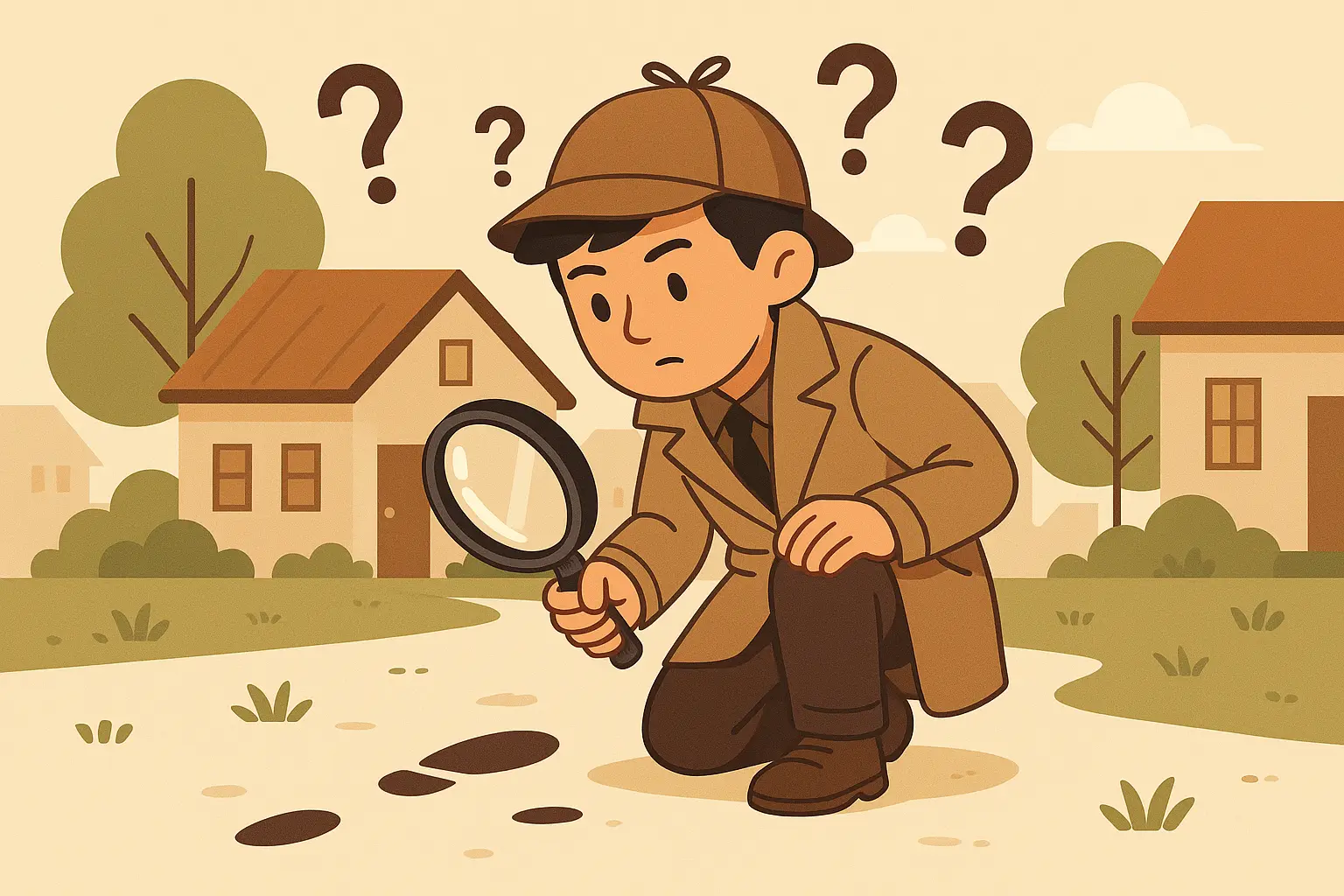
12. Nate the Great Series
Marjorie Weinman Sharmat’s young detective models systematic thinking and evidence evaluation. Nate approaches each case methodically, showing kids how to break down problems and think logically.
The stories provide frameworks kids can use for real-world problems, whether they’re looking for lost homework or trying to figure out why their friend is upset. It’s practical life skills disguised as entertainment.
13. The A to Z Mysteries Series
Ron Roy’s alphabet-themed series gives kids a systematic approach to mysteries while building anticipation. Three friends solve crimes in their town, and the alphabet structure means there’s always another adventure coming.
Each book introduces different mystery types and problem-solving approaches, helping kids develop flexible thinking skills. The friendship dynamic adds emotional investment to the logical puzzle-solving.
14. Encyclopedia Brown Series
Donald J. Sobol’s interactive mysteries are perfect for kids who like to feel smart. Each book has 10 short cases, and readers get to solve them before checking the answers.
Encyclopedia Brown uses logical deduction and careful observation to solve cases, and kids can follow along with his thinking process. When they figure out a case on their own, they feel like genuine detectives.
|
Mystery Series |
Length |
What Makes It Special |
Skills It Builds |
|---|---|---|---|
|
Cam Jansen |
60 pages |
Photographic memory concept |
Observation, attention to detail |
|
Nate the Great |
64 pages |
Systematic investigation |
Logical thinking, methodology |
|
A to Z Mysteries |
80 pages |
Alphabet progression, teamwork |
Collaboration, flexible thinking |
|
Encyclopedia Brown |
Short cases |
Interactive challenge format |
Deductive reasoning, evidence evaluation |
Educational and STEM Stories (4 Stories)
The best educational stories are sneaky about teaching. Kids think they’re just reading exciting adventures, but they’re actually learning about science, history, and how the world works.
15. The Magic School Bus Chapter Books
Ms. Frizzle’s class adventures make science concepts accessible through exciting storylines. The chapter book format allows for deeper exploration than the picture books, while maintaining the series’ perfect blend of education and entertainment.
Scientific vocabulary gets introduced naturally through the adventure context. Kids learn about ecosystems while following the class through a rainforest, or understand weather patterns while chasing storms. It never feels like a textbook.

16. Who Was? Series
These biographical books make historical figures feel like real people with interesting stories. Instead of dry facts, kids get chronological narratives about people who changed the world.
Each book builds historical vocabulary while presenting complex time periods through engaging personal stories. Kids learn about ancient Rome through Julius Caesar’s life, or understand the civil rights movement through Rosa Parks’ experiences.
17. National Geographic Readers
These non-fiction books combine stunning photographs with age-appropriate text. The visual support helps kids understand complex concepts while building domain-specific vocabulary.
Whether it’s sharks, space, or ancient civilizations, these books prove that factual information can be just as exciting as fiction. The combination of visual and textual information works for different learning
18. The Wild Robot
Peter Brown’s 279-page novel tells the story of Roz, a robot stranded on an island who must learn to survive and communicate with wildlife. It’s like Cast Away meets Wall-E, and kids absolutely love it.
The story explores big themes about artificial intelligence, environmental science, and what makes someone “real,” but it never feels heavy-handed. When Roz learns to communicate with the island animals, kids naturally absorb vocabulary about ecosystems, animal behavior, and adaptation without realizing they’re getting a science lesson.
The robot’s need to understand seasonal migration patterns becomes an engaging plot point that teaches scientific concepts without feeling textbook-heavy. It’s the kind of book that makes kids ask great questions about technology, nature, and what it means to belong somewhere.
Diverse and Cultural Stories (4 Stories)
These books show kids that the world is bigger and more interesting than their own neighborhood. They introduce different perspectives, traditions, and experiences while celebrating what makes us all human.
19. Last Stop on Market Street
Matt de la Peña’s Newbery Medal-winning story follows CJ and his grandmother on their weekly bus journey through the city. CJ starts out complaining about their routine, but his grandmother helps him see beauty and purpose in their urban environment.
The poetic language introduces new vocabulary while exploring themes of gratitude, community service, and finding joy in everyday experiences. Kids learn that different doesn’t mean less-than, and that every community has its own beauty and value.
20. Alma and How She Got Her Name
Juana Martinez-Neal’s story features a girl learning about her incredibly long name’s significance. Each part of Alma’s name connects to a family member with their own story of strength, creativity, and cultural heritage.
Kids learn that names carry meaning and connect us to our history. The story uses cultural elements as natural vocabulary-building opportunities while celebrating the importance of family stories and cultural identity.

21. The Year of the Book
Andrea Cheng’s novel follows a Chinese-American girl navigating fourth grade and bicultural identity. She’s balancing her family’s expectations with her desire to fit in at school – something many kids can relate to, regardless of their background.
The story provides authentic cultural details while addressing universal themes of friendship, family expectations, and finding your place when you feel caught between two worlds.
22. Islandborn
Junot Díaz’s picture book tells the story of a girl learning about her Caribbean homeland through community stories. When she’s assigned to draw her country of origin, she discovers rich cultural heritage through neighbors’ memories.
The community storytelling structure introduces Caribbean cultural elements naturally while celebrating how heritage shapes identity across generations. These stories for kids show how our backgrounds make us who we are, even when we’re far from where we started.
Humor and Light-hearted Stories (3 Stories)
Sometimes kids just need to laugh. Humor stories provide stress relief, help with emotional regulation, and give kids something fun to share with friends.
23. Dog Man Series
Dav Pilkey’s graphic novel series combines superhero action with bathroom humor that speaks directly to 7-year-olds’ sense of comedy. The comic book format supports reading through visual cues and familiar superhero conventions.
The visual gags and physical comedy provide natural pause points for giggles while maintaining story momentum. Kids love the deliberately silly humor, and parents appreciate that the underlying messages about friendship and doing the right thing are actually pretty solid.
24. Captain Underpants Series
Dav Pilkey’s classic series features two boys who hypnotize their principal into becoming a superhero. It’s every kid’s fantasy about authority figures, wrapped up in action sequences and friendship dynamics.
The series uses simple language with sophisticated visual storytelling, making it accessible to struggling readers while providing enough complexity to engage advanced readers. The bathroom humor serves as a gateway to appreciating more sophisticated comedy later.
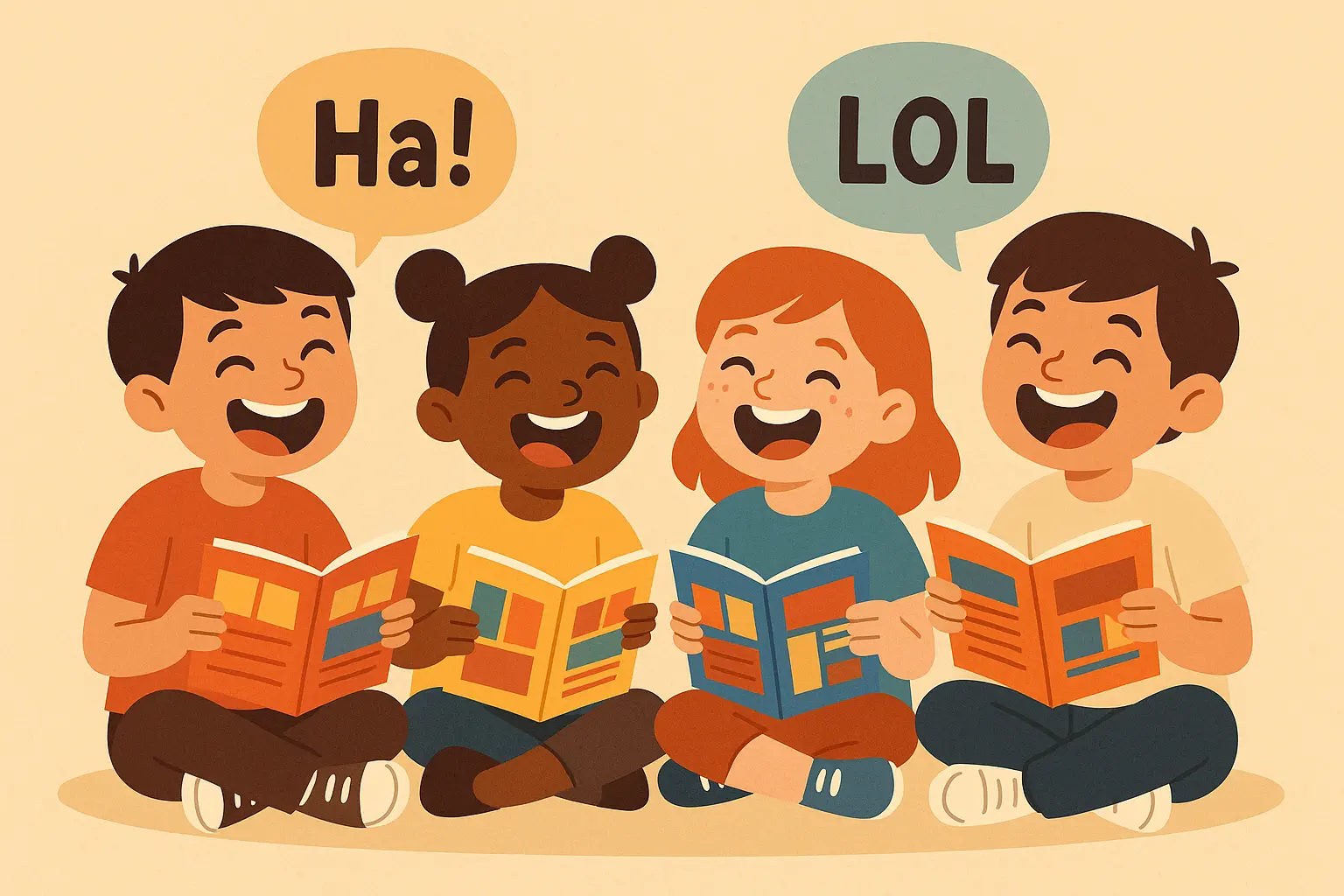
25. Lunch Lady Series
Jarrett J. Krosoczka’s graphic novels feature a school lunch lady who moonlights as a crime fighter. The familiar school setting combined with unexpected adventure creates humor through contrast and surprise.
The series shows kids that ordinary people can be extraordinary, encouraging them to look for heroic qualities in unexpected places. Plus, it makes school lunch seem way more exciting than it actually is.
Why These Stories Actually Work
Look, I know all this talk about “developmental criteria” sounds pretty academic, but here’s the real deal: these books work because they hit that sweet spot where kids don’t feel like they’re being taught, but they’re actually learning a ton.
Understanding effective narrative structures becomes clearer when examining story theme examples that demonstrate how themes can be woven naturally into age-appropriate content without overwhelming young readers.
When I watch my neighbor’s 7-year-old devour Magic Tree House books, she’s not thinking about “vocabulary expansion” – she’s just excited that Jack and Annie are about to meet dinosaurs. But guess what? She’s picking up words like “Cretaceous” and “paleontologist” without even realizing it.
The friendship stories like Ivy and Bean? They’re basically like having a practice run for real-life social situations. Kids see how the characters handle disagreements and think, “Oh, maybe I could try that with my friend too.”
And those mystery books? Your kid becomes a detective, feeling super smart when they figure out the clues. Encyclopedia Brown made my nephew feel like a genius – he’d walk around the house looking for “cases” to solve.
Reading Levels That Actually Make Sense
These books operate at reading levels between 380-650 Lexile, which is perfect for transitioning readers. The short chapters and clear story structures provide support while introducing challenging vocabulary through context clues.
Adventure stories use exciting plots to carry kids through new words, while friendship stories use authentic dialogue that reflects how children actually speak. Mystery series employ repetitive structures that build confidence, and educational stories balance scientific vocabulary with visual support.
|
Story Type |
What Works |
Why Kids Love It |
|---|---|---|
|
Adventure/Fantasy |
Big imagination, manageable challenges |
They feel brave and capable |
|
Friendship/Social |
Real problems, realistic solutions |
They see themselves in the characters |
|
Mystery/Problem-Solving |
Smart kids solving problems |
They feel clever and important |
|
Educational/STEM |
Learning disguised as fun |
They don’t realize they’re being educated |
|
Diverse/Cultural |
Different worlds, universal themes |
They discover the world is bigger than they thought |
|
Humor/Light-hearted |
Pure entertainment value |
They get to laugh and be silly |
Attention Spans and Story Structure That Work
Seven-year-olds can focus for 15-30 minutes on stories they actually enjoy. These books use chapter structures with natural stopping points – kids feel accomplished finishing a chapter, and cliffhangers keep them coming back.
Magic Tree House books at 68 pages provide complete adventures within optimal reading sessions. Princess in Black series uses illustrations to create visual breaks that accommodate different attention spans.

Making Reading Time Work in Real Life
Okay, “advanced implementation” sounds intimidating, but this is really just about making reading time work better in your actual life.
When implementing these stories effectively, understanding the brain science behind effective storytelling can help parents and educators maximize the developmental benefits while maintaining high engagement levels.
At Home: What Actually Works
We all have good intentions about reading together, but let’s be real – some nights you’re exhausted and the last thing you want is a 20-minute reading session. Here’s what actually works:
The Magic Tree House hack: These books are short enough that you can read one together in about 15 minutes, but exciting enough that your kid will beg for “just one more chapter.” Win-win.
Series are your friend: Once your kid falls in love with characters, half your work is done. They’ll actually ask to read, instead of you having to bribe them.
Mix it up: Some nights you read to them, some nights they read to you, and some nights you take turns with different voices for characters. My sister does different accents for all the Princess in Black characters, and her daughter thinks it’s hilarious.
For Teachers: What Actually Works in Classrooms
If you’re a teacher, you probably already know that getting a whole class excited about the same book is like herding cats. But these books give you options:
The graphic novels (Dog Man, Wings of Fire) are great equalizers – struggling readers can follow the story through pictures, while advanced readers enjoy the complex plots.
Mystery books work great for group discussions because everyone can share their theories. I’ve seen kids who never participate suddenly become super engaged when they think they’ve solved the case.
Library and Community Stuff
Librarians, you’re the real MVPs here. These books are perfect for mixed-age story times because the humor works for different levels, and the adventure stories keep everyone engaged.
Pro tip from a librarian friend: Do a “mystery week” with Encyclopedia Brown stories and let kids solve cases together. They’ll feel like detectives and beg their parents to check out more books.
Dealing with Different Learning Styles
Visual learners love the graphic novels and illustrated chapter books. The professional comic formatting supports comprehension through visual storytelling.
Auditory learners connect with stories featuring strong dialogue and rhythm, like the conversational tones in Ivy and Bean or Junie B. Jones.
Kinesthetic learners engage with action-adventure stories and interactive mysteries that encourage physical involvement beyond passive reading.
Social learners thrive with friendship-focused narratives that provide discussion opportunities and connection points during shared reading experiences.
When Reading Is Challenging
For kids with dyslexia: Many graphic novels and illustrated chapter books provide visual support that reduces reading strain while maintaining story complexity.
For shorter attention spans: Books with shorter chapters and high-interest topics maintain engagement. Series provide complete satisfaction in manageable chunks.
For different processing speeds: Stories with predictable structures and familiar themes provide comfort through familiarity while introducing new challenges gradually.
For vocabulary support: Books with strong context clues and visual aids help kids understand new words through multiple pathways.
How Nairrate Can Help Create Perfect Stories
Here’s the thing – even with all these amazing books, sometimes you need something specific. Maybe your kid is obsessed with dolphins and wants every story to feature marine life. Or maybe they’re going through a phase where they only want stories about kids who look like them.
For parents and educators looking to create custom content, exploring bedtime stories that actually work demonstrates how effective narrative elements can be incorporated into personalized stories that meet specific developmental needs.
Finding stories that perfectly match your 7-year-old’s reading level, interests, and developmental needs often feels impossible. You might discover a book with the right vocabulary level but themes that don’t resonate, or find engaging characters in stories that are too advanced or too simple.
That’s where custom story creation comes in handy. Instead of spending hours searching for the perfect book that probably doesn’t exist, you can create exactly what your kid needs.
Think about it: What if you could make a mystery story featuring your child’s name and their best friend, set in their actual neighborhood? Or an adventure story that incorporates their current obsession (whether that’s dinosaurs, space, or hamsters)?
Nairrate’s Story Starters Generator creates compelling openings tailored specifically for 7-year-olds, incorporating all the developmental considerations we’ve discussed. Whether you need a mystery that builds deductive reasoning skills or an adventure that introduces new vocabulary, the AI understands what makes stories work for this age group.
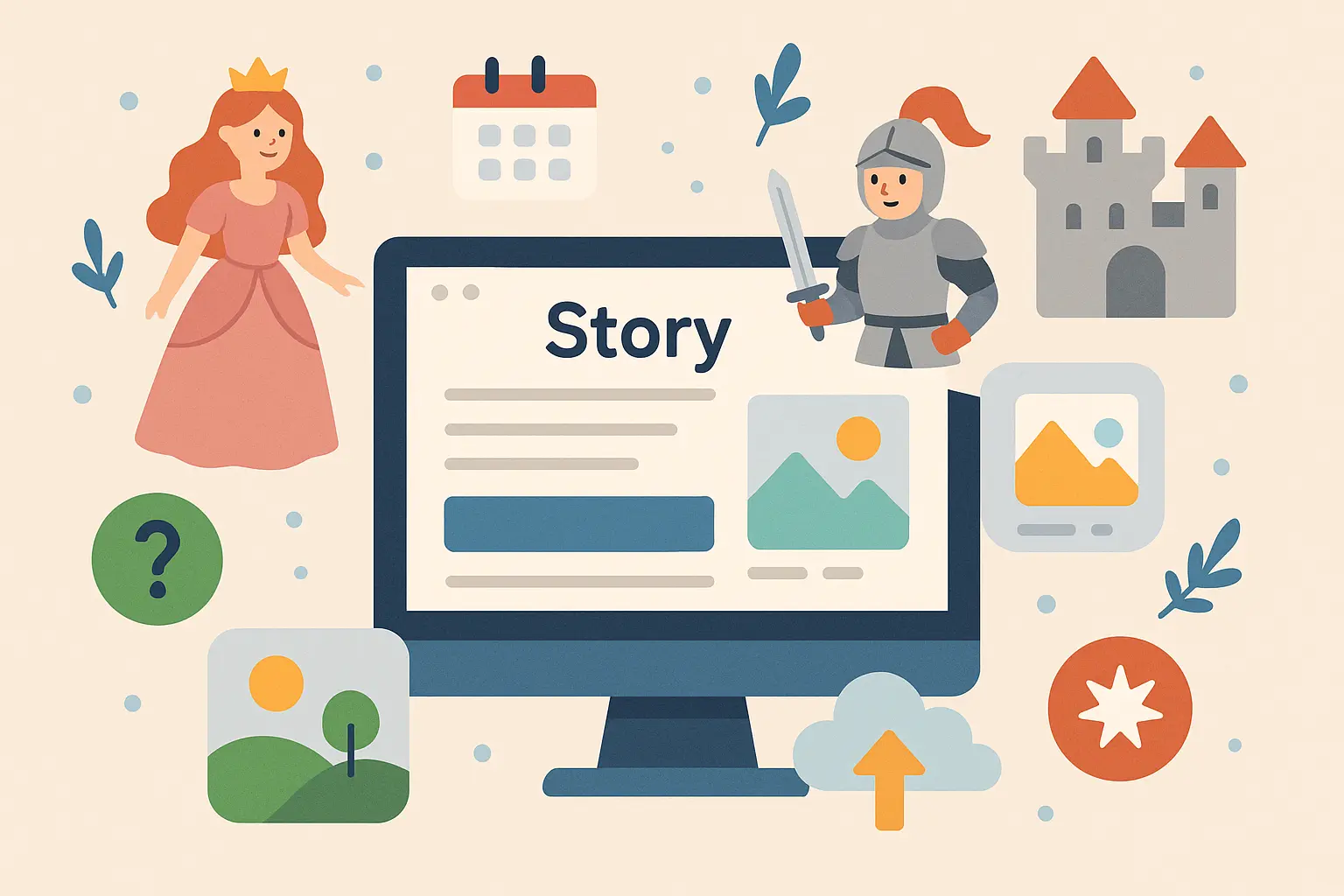
The cool thing about AI story generation is that it understands what makes stories work for 7-year-olds – the right vocabulary level, proper story structure, characters they’ll connect with. It’s like having a children’s book author on speed dial.
Educational integration becomes seamless when you can create stories that align with specific learning objectives while maintaining entertainment value. Supporting different learning styles works when you can design content to work alongside visual elements or interactive components.
Real talk: Sometimes the best stories are the ones made just for your kid. And honestly, there’s something pretty magical about seeing their face when they realize they’re the hero of their very own adventure.
Ready to create the perfect story for your 7-year-old? Visit Nairrate today and discover how AI-powered story generation can provide exactly the content your child needs to fall in love with reading.
Final Thoughts
Look, I could keep going with more recommendations and analysis, but here’s the bottom line: reading should be fun. Not educational-fun or good-for-you-fun, but actually, genuinely fun.
These 25 stories? They’re battle-tested. They’ve survived countless bedtimes, classroom read-alouds, and “I’m bored” moments. They’ve turned reluctant readers into book lovers and given parents something to actually look forward to during reading time.
Will every single book work for your kid? Probably not. My friend’s son loved Dog Man but thought Magic Tree House was “too babyish.” Another kid I know devoured the entire Wings of Fire series but couldn’t get into Junie B. Jones. That’s totally normal.
The goal isn’t to find the perfect book – it’s to find enough good books that your kid starts to trust that reading can be awesome. Once that happens, they’ll start seeking out books on their own, and that’s when the real magic begins.
Remember, every child develops at their own pace, and what captivates one 7-year-old might not interest another. The key is offering variety while maintaining quality standards that support reading development, emotional growth, and educational enrichment.
Whether you’re a parent seeking bedtime stories that actually hold your child’s attention, an educator looking for classroom-appropriate books that serve multiple learning objectives, or a caregiver wanting to foster a lifelong love of reading, these selections offer proven pathways to success.
Bottom line: Don’t stress too much about finding the “perfect” educational book. Focus on finding stories your kid actually wants to read. The learning will happen naturally, and you’ll both have a lot more fun in the process.
Trust me on this one – a kid who loves reading will learn everything they need to learn. Your job is just to help them fall in love with stories. These 25 books are a pretty great place to start.



Add comment